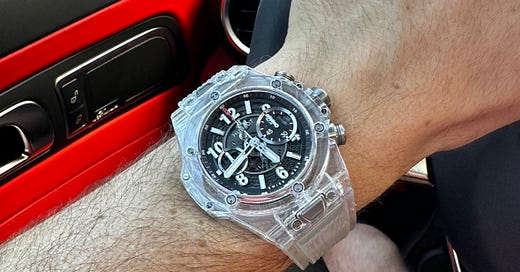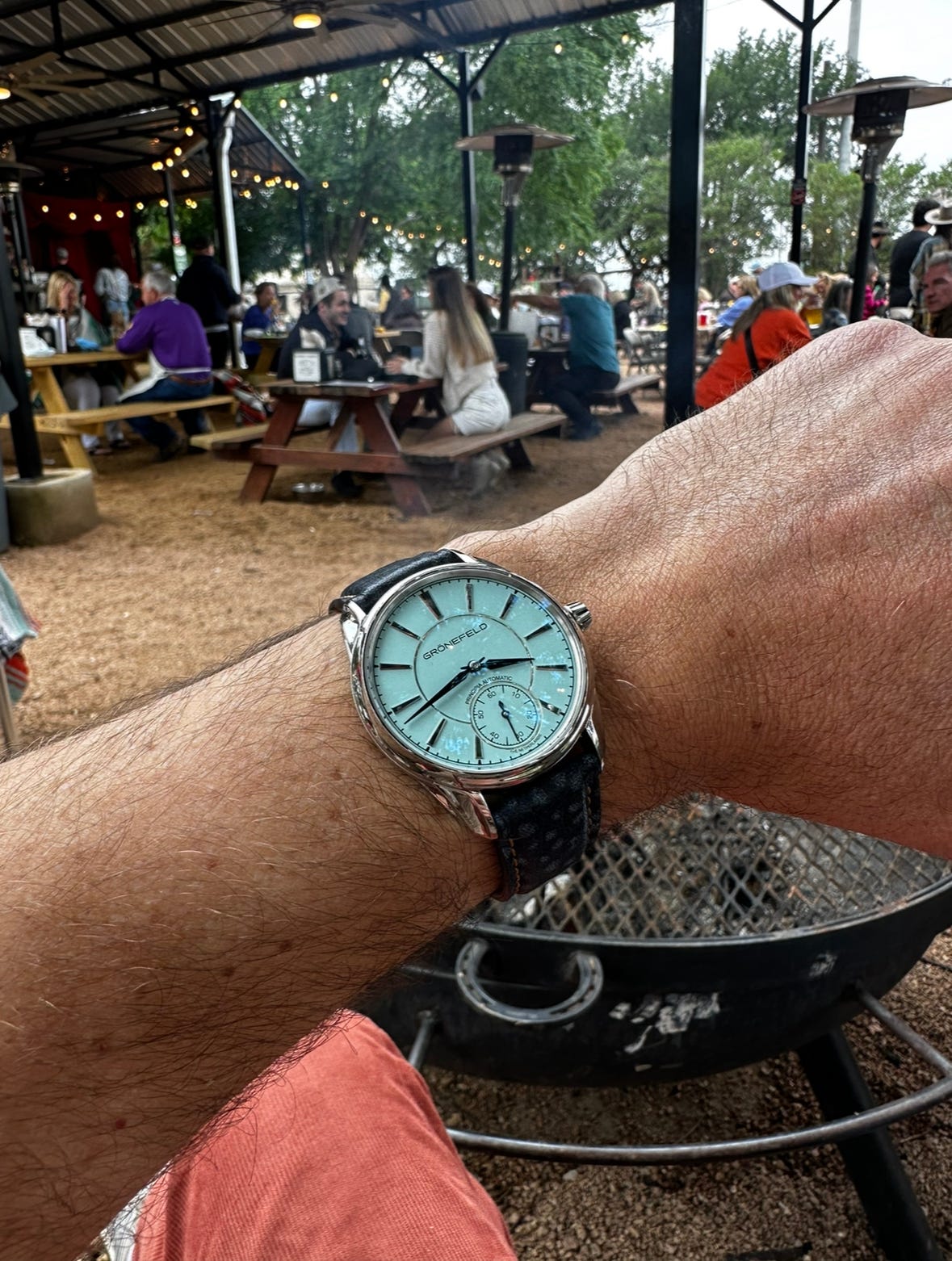After a week of hard work, the Swiss watch industry took this week off. While they were soaking in hot springs in the Alps and watch influencers boarded their business class flights home to all corners of the world, a hush of quiet fell across the horological internet — the perfect time to reflect and share some of the goings on in our own watch universe.
Battle of the G-Shocks for the Wealthy
Last week we indulged in a guilty pleasure: a (gasp) HUBLOT! Of course we are long on record as liking certain models from them, and confused by the overall hate they receive. But still it came as a surprise when we posted a pic of a sapphire Big Bang. It is only upon posting a heretical new addition that one can feel the failure mode of the old adage, “Buy What You Like.”
One of the reasons we still buy personal watches and try to approach purchases as a collector sometimes is to remain aware of what it’s like for our customers in the real world. Girardian effects are real. Upon sharing a large new purchase, most people want to receive praise, be it online or in real life. After all, everyone knows that a man’s choice of watch says something about him. Did we make a mistake? Are we sending the wrong message? Doubts creep in.
No one on the internet is concerned with your money. One of the funniest comments we received was a few negative messages from a well-followed watch account who almost immediately after posted a picture of an NTPT RM011 that received universal acclaim. We would love to hear a cogent argument on why a plastic RM of questionable horological value is clearly better than a sapphire Hublot at approx 10x the price. Of course at even money, anyone would take the RM (although we could make an argument that that is still irrational), but with the price differential the conversation should be more nuanced. But internet commenters love to spend other peoples’ money, so price is never factored in. “How stupid to buy a Girard Perregaux Minute Repeater when you should have bought a Patek Minute Repeater!” To partake in internet discourse and still build an interesting personal collection, one must identify this tendency and reject it fully.
We will write a longer post on how we go about identifying interesting watches and value soon (probably for paid-subs, sorry). One thing is clear, though: “Buy what you like,” is easier said than done, but still is the best advice to get any spiritual fulfillment from this hobby.
Fishy Auctions?
This one we post mostly as a curiosity. We don’t know the poster. But this article on the veracity of a mega-Speedmaster is interesting. We’ve long held that certain auction results don’t seem right. We know good people that work at Phillips, so do not want to unfairly malign, but with this much money at stake it’s not impossible that shady business goes down and not everything can be caught. Anyway it’s a good read — reminds me of the sort of scholarship that was common back in the forum days. I wish there was more of this present now.
.
Bitcoin Transactions
For several years now we have accepted Bitcoin, but unfortunately only a handful of customers have taken us up on it (mainly us buying in Bitcoin vs selling). Recently we completed a sale in Bitcoin and had to rave about how great it is vs bank wires.
For those who have never sent a bitcoin transaction, it is as easy as copying or scanning the receiving address into your wallet and pressing send. The fee on this six-figure transaction was about $1 and it arrived instantly ON A SUNDAY. In this case, we had a few serious inquiries on the watch. This customer’s ability to close the deal on Sunday gave him the edge.
We have long been Bitcoin proponents. Method of exchange is not even in the top reasons why. But for large watch transactions that usually rely on wires, it is unquestionably superior. We do not believe it likely that Bitcoin ever takes over mainstream finance, but this sort of transacting is clearly the future one way or another.
The Market
We’ll end with a view on the watch market overall as this is a question we often get. The massive Fed printing created an everything bubble and sent many watch values through the roof. Now popped, most have gently glided back down to Earth. In fact this process has been much more gentle than we expected. Values seem to be finding a stable “new normal” that is still above where they were, but no longer insane. This is healthy. All of the hype did result in actual new and lasting demand — more buyers looking at more brands. The independents in particular have gone much more mainstream (in some ways to our chagrin). Many of our sales now are to first time buyers.
It has long been our contention that the old days of good watches immediately worth 40-50 cents on retail made no sense. The following seems most rational:
New watches sell for 90-100% of retail price (in the old days this was 70-95% usually)
Most used watches 70-90% of new price (this was 30-80%)
Oversubscribed watches sell used for similar to new (still often was 60-80%)
The most special, rare, desired pieces sell over retail to whatever extent (this always existed but applied to very few pieces. During the bubble, this category extended much further than it should)
So overall we see prices trending toward a very healthy place. Whenever demand changes rapidly, buyers get more hesitant. There’s a feeling that we don’t know how bad the economy could get, or at least that there’s no rush to purchase. The frenzy of having to buy today lest the watch be gone tomorrow or only available at a higher price gets replaced by careful consideration. This too is healthy. When paired with fair prices, it leaves real buyers buying watches that they actually want. We at TickTocking prefer this market and these buyers and look forward to dealing with all of you soon
.




